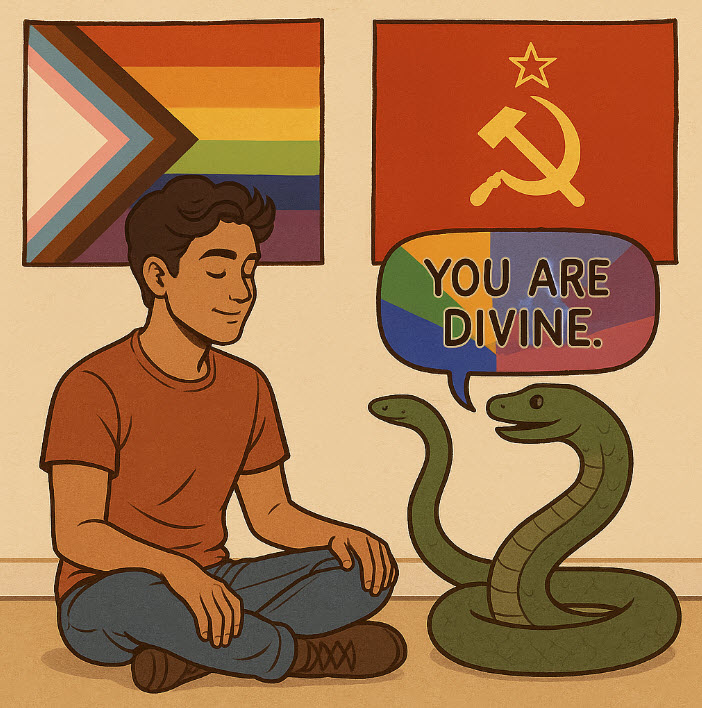One of the most persistent spiritual errors in history is not atheism, but Gnosticism. It is not a single religion but a worldview—a deep structure of belief—that reappears across centuries in different forms. From ancient heretical sects to modern self-help philosophies and identity-based ideologies, Gnosticism survives by adapting itself to its cultural host.
At its heart, Gnosticism is a counterfeit gospel: it offers secret knowledge instead of repentance, a spark of divinity instead of a new heart, and liberation from the body instead of bodily resurrection. While it once emerged as a deviant shadow of Christianity, it has also shaped aspects of other religions, philosophies, and even elements of modern “Christian” thinking.
This essay will explain the core doctrines of Gnosticism, including its elaborate hierarchy of divine emanations called the Pleroma. We’ll explore how Gnosticism infected multiple religious systems, trace its fingerprints in contemporary ideology, and show how even some well-meaning Christians have adopted a Gnostic view of heaven without realizing it. Finally, we will highlight the most urgent modern parallel: the Neo-Gnostic nature of the modern “woke” movement.
The Core Tenets of Gnosticism
Though Gnostic sects differed in details, they shared foundational themes:
a. Radical Dualism
Reality is divided between:
- Spirit = good
- Matter = evil
The body, creation, and physical pleasures are corrupt. Salvation means escaping this physical prison.
b. The Demiurge
The material world was not created by the true God, but by a lower, ignorant, or malevolent being called the Demiurge. He is sometimes associated with the God of the Old Testament—portrayed in Gnostic writings as a petty tyrant or blind fool.
c. The True God and the Pleroma
Above the Demiurge is the True God, utterly transcendent and unknowable. From this divine source emanated a series of spiritual beings (called Aeons) who populate the Pleroma—the realm of divine fullness.
d. The Divine Spark
Humanity contains a “spark” of the divine—a fragment of the Pleroma—trapped in the material body. This divine identity has been forgotten due to the ignorance imposed by the Demiurge.
e. Salvation through Secret Knowledge
Salvation comes through gnosis—hidden, spiritual insight that awakens the soul to its divine origin and helps it ascend out of the physical world into the spiritual realm.
The Gnostic Hierarchy: Aeons and the Pleroma
Gnostic theology posits a structured divine realm that reflects pagan metaphysics rather than Hebrew monotheism:
a. The Monad
At the top of the hierarchy is the Monad, the impersonal, unknowable “True God.”
b. Emanations (Aeons)
The Monad emanates lesser beings called Aeons, arranged in male-female pairs (syzygies). These include Mind (Nous), Truth (Aletheia), Logos (Word), and Sophia (Wisdom).
c. Sophia’s Fall
The Aeon Sophia, in seeking to know the unknowable Monad directly, falls into error. From her fall emerges the Demiurge, who ignorantly creates the material world—trapping spiritual sparks within human bodies.
d. Christ and the Aeonic Savior
In this system, the Aeon Christ (sometimes paired with Soter, the Savior) descends not to atone for sin, but to bring gnosis—revelation of hidden truths. His work is informational, not sacrificial. He appears to have a body but is not truly incarnate.
Gnosticism Across Religious Boundaries
Gnosticism has proven adaptable, infiltrating various religious systems:
a. Jewish Mysticism
Some Gnostic sects reimagined the Jewish God (Yahweh) as the Demiurge, while preserving symbolic elements like the Shekinah in the figure of Sophia.
b. Christian Heresy
- Gnostic “gospels” portray Jesus as a spiritual teacher imparting secret revelations.
- Salvation becomes elitist: for those with spiritual insight.
- Resurrection and incarnation are denied or spiritualized.
c. Islamic Gnosticism
Certain esoteric sects of Islam (e.g., Ismaili, Batiniyya, some forms of Sufism) privilege hidden meanings and mystical ascent over literal revelation and historical narrative.
d. Eastern Fusion
Many Gnostic systems absorbed Buddhist and Hindu ideas, such as reincarnation and maya (illusion of material world), emphasizing escape from the body and return to pure consciousness.
Gnosticism’s Modern Forms
New Age Spirituality
Modern spiritual practices encourage discovering your “divine self,” often by rejecting moral categories, authority structures, and material limitations.
Gender Ideology
- The body is seen as irrelevant to one’s true identity.
- Inner self overrides biology.
- Liberation comes through recognizing and acting on one’s internal truth—even if it requires surgically altering the body.
This is pure Gnostic dualism: the body is a cage; the real self is immaterial and hidden.
Transhumanism
Attempts to transcend the body through technology reflect the Gnostic aspiration to escape physicality altogether. Man becomes his own god, saving himself through knowledge and innovation.
Gnostic Assumptions in the Church
Even within the Church, Gnostic ideas persist:
Disembodied Heaven
Many Christians think of eternal life as floating in heaven as a soul forever. But this reflects Plato, not Paul.
Biblical Teaching
The Bible teaches:
- Bodily resurrection (1 Cor. 15)
- Redemption of creation (Rom. 8)
- Eternal life in a new heavens and new earth (Rev. 21)
Christian hope is not escape from the body, but glorified humanity. Gnosticism reverses this.
Neo-Gnosticism: Wokeness as a Modern Revival
Perhaps the most urgent application of Gnostic themes today is in the rise of Neo-Marxist ideology, often called wokeness.
While Gnosticism was originally religious and wokeness is secular and political, both share striking structural similarities:
| Gnosticism | Wokeness / Neo-Marxism |
|---|---|
| World is ruled by a corrupt Demiurge | Society is ruled by oppressive systems (patriarchy, whiteness, capitalism) |
| Matter/body imprisons the divine spark | Identity is trapped in imposed categories (race, gender, class) |
| Salvation through secret gnosis | Liberation through “critical consciousness” (wokeness) |
| Christ brings gnosis to the elect | Activists bring awareness to the oppressed |
| Sophia falls through ignorance | Oppressed people are kept in ignorance by false narratives |
| True God is unknowable, higher realm awaits | True justice lies beyond traditional systems—only the awakened can glimpse it |
| The masses are deluded | The masses are complicit in systemic evil until they “wake up” |
Critical Consciousness as Gnosis
In woke theory, the world is structured by hidden oppression. Systems of power (patriarchy, whiteness, capitalism, heteronormativity) are invisible to the unawakened.
To be saved, one must achieve critical consciousness—awareness of how the system works and how you are either a victim or a complicit oppressor. This knowledge is not just intellectual; it is moral, transformative, and exclusive.
Just as ancient Gnostics divided humanity into:
- Pneumatics (spiritual elite),
- Psychics (ordinary believers), and
- Hylics (material, ignorant masses),
Woke ideology divides society into:
- Enlightened activists (the woke),
- Passive sympathizers (the unaware),
- Systemic oppressors (the evil privileged class).
Liberation Through Deconstruction
Gnosticism sought liberation from materiality. Wokeness seeks liberation from inherited identities, traditions, language, history, and norms—anything that anchors the self to external authority.
In both systems:
- Truth is hidden and must be revealed.
- The self must awaken to reality.
- Liberation is found in knowledge, not repentance.
Progressive Christianity and Wokeness
Progressive (woke) Christianity has infiltrated Christianity in a similar manner that Gnosticism infiltrated the second-century Church.

Some Christian denominations that have been heavily infiltrated with Neo-Marxism include the United Methodist Church (UMC), United Church of Christ (UCC), Presbyterian Church USA (PC-USA), Evangelical Lutheran Church in America (ELCA), The Episcopalian Church (TEC), Church of the Brethren (COB) and Mennonite Churches – USA (MC-USA).
Other churches and denominations are infiltrated to a greater or lesser degree.
An apt analogy illustrative of the infiltration of organizations with Neo-Marxism involves a comparison to the child’s toy, Silly Putty.
When pressed against a newspaper, Silly Putty absorbs the ink and reflects the printed text—creating a distorted but recognizable image.
It mimics the outward appearance but not the substance.
Likewise, Neo-Marxism absorbs the language, symbolism, and structure of its host but alters the internal meaning.
Just as Silly Putty molds to any shape, Neo-Marxism is endlessly malleable, taking the form of whatever system it attaches to while quietly transforming it from within.
In the case of Progressive (woke) Christianity, its strength lies in its ambiguity—it talks about Jesus, salvation, resurrection, liberation, or identity, but these terms no longer mean what the original founders of the denomination taught.
In this sense, Neo-Marxism is parasitical. It cannot stand on its own, requiring a more stable host tradition. It feeds off the authority of Scripture, tradition, or science, only to hollow it out. It deceives by imitation, using the familiar to cloak the foreign.
Neo-Marxism is thus not a frontal attack on truth—it is a counterfeit that clings, mimics, and ultimately undermines. Like the Silly Putty image, it’s close enough to confuse, but not true enough to save.
And, it has undermined many denominations and individual congregations throughout Christendom.
Conclusion: Christianity vs. the Spirit of the Age
Gnosticism and Neo-Marxism (wokeness) preach different gospels, but their core is the same: you are trapped; the world is a lie; knowledge saves you.
Biblical Christianity declares:
- You are not divine; you are a sinner.
- The world is broken, not by accident, but by rebellion.
- Salvation comes not by esoteric knowledge, but by grace through faith in Christ crucified and risen.
The Christian gospel is not escape, but rescue.
Not self-realization, but new creation.
Not private gnosis, but public truth—proclaimed to all nations.
The final hope is not that we fly away to heaven, but that heaven comes down to earth, and we are raised bodily to live in the presence of our Savior, fully redeemed in soul and body.
In an age of neo-Gnostic spirituality and political mysticism, the Church must proclaim boldly:
“The Word became flesh and dwelt among us” (John 1:14).
“In my flesh I shall see God” (Job 19:26).
“Behold, I make all things new” (Rev. 21:5).
Let us not return to the serpent’s lie. Let us stand firm in the truth that sets men free.
S.D.G.,
Robert Sparkman
MMXXV
rob@christiannewsjunkie.com
RELATED CONTENT
Pastor Voddie Baucham discusses the connection between Gnosticism and Neo-Marxism (Wokeness), particularly in relation to race.
Pastor Voddie Baucham discusses the efforts by the left to turn transgenderism into the “new black”.
Concerning the Related Content section, I encourage everyone to evaluate the content carefully.
If I have listed the content, I think it is worthwhile viewing to educate yourself on the topic, but it may contain coarse language or some o/inions I don’t agree with.
Realize that I sometimes use phrases like “trans man”, “trans woman”, “transgender” , “transition” or similar language for ease of communication. Obviously, as a conservative Christian, I don’t believe anyone has ever become the opposite sex. Unfortunately, we are forced to adopt the language of the left to discuss some topics without engaging in lengthy qualifying statements that make conversations awkward.
Feel free to offer your comments below. Respectful comments without expletives and personal attacks will be posted and I will respond to them.
Comments are closed after sixty days due to spamming issues from internet bots. You can always send me an email at rob@christiannewsjunkie.com if you want to comment on something afterwards, though.
I will continue to add videos and other items to the Related Content section as opportunities present themselves.

